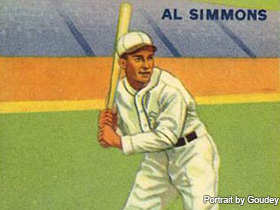You are here

5/20/1902 - 5/26/1956
"Bucketfoot" Al Simmons played outfield for the Athletics from 1924 to 1935.
Al Szymanski was born May 22, 1902, in Milwaukee, Wisconsin. As a boy he dreamed of playing baseball for the Philadelphia Athletics. Early in his career, Szymanski changed his name to Simmons when he grew tired of scorekeepers constantly mispronouncing it. Simmons was a natural; in his second year he led the Athletics in all batting categories. He went on to be one of the most prolific batters of his time, leading the league in most categories every year. Simmons played for 17 years, and he coached for 10 years. In 1956, he moved back to Milwaukee. He died on May 26, 1956.
Aloysius Szymanski was born May 22, 1902 in Milwaukee, Wisconsin, and he was the son of Polish immigrants. He grew up playing sandlot baseball there, but the Philadelphia Athletics quickly became his favorite team. Szymanski knew at a young age that he wanted to play baseball in the major league. According to the Philadelphia Athletics Historical Society, Szymanski came home from the fourth grade one afternoon and proudly announced that he was going to be a professional baseball player. Szymanski's hardworking father insisted that Al's future was in the butcher business with him and reached for his strap. Even after a beating, Szymanski defiantly insisted that he was going to play professional baseball, at which point his father told him that he "better be a good one."
Szymanski began to write several letters to the Athletics manger, Connie Mack, asking for a tryout. In 1922, Szymanski signed on with his hometown minor league team, the Milwaukee Brewers. During his brief stint in Milwaukee, Szymanski quickly grew tired of scorekeepers and other officials mispronouncing his last name. During a game one afternoon, Szymanski noticed a large advertisement for "Simmons Hardware" and promptly adopted his new name, Al Simmons. During his 24-game trial in Milwaukee, Simmons had an impressive .398 batting average, and the Brewers realized they had a potential star on their hands. His remarkable start allowed the Brewers to sell Simmons to the Philadelphia Athletics for around $50,000 in 1923.
Simmons was 21 years old when he made his professional debut with the Philadelphia Athletics in April 1924. At spring training he quickly earned the nickname "Bucketfoot" due to his unusual batting stride. Instead of stepping straight towards the pitcher, he stepped away from the plate, towards third base. According to the Philadelphia Athletics Historical Society, "It looked like he swung with one foot in a bucket." Nevertheless, Manager Connie Mack recognized his natural batting talent and would not allow anyone to change his style. Mack turned out to be right about the untested rookie. Simmons batted .308 in his first year and raised his average to .384 in his second. In his second year on the team, Simmons led the Athletics every hitting category. Simmons also became the first player in American League history to knock in 100 or more runs in his first two seasons in the majors. Simmons was also an excellent outfielder.
Much of Simmons's early success was attributed to his unusual batting style. The fact that the right-hander stepped away from the strike zone meant pitchers would try to throw to the outside corner of the plate. His combination of long arms and one of the longest bats in the majors meant he could still hit the outside pitches. Simmons attributed many of his hits to a "long bat and an unbelieving pitcher."
In 1927, the Athletics added player Ty Cobb, who helped Simmons become an even better hitter. The two easily became friends, which may have added to Simmons's growing infamy. As his fame grew, so did the reputation of his temper and his hatred for pitchers. He was quoted saying, "I hate all pitchers. They are trying to take the bread and butter out of my mouth." Opposing hitters also disliked him more and more as well. Simmons became quite an agitator all the way from his position in left field. Despite his reputation on the field, Simmons was getting almost as much fan mail as Babe Ruth. It should be noted, however, that he received most of his letters from female admirers and not star-stuck boys. With his good looks and flashy clothes, Simmons loved the nightlife and a good cigar.
The highlight of Simmons's career came two years later in 1929 when he and the As beat the Chicago Cubs to win their first of three consecutive world championships. In that series Simmons led one of the greatest World Series come from behind victories of all time. The Athletics trailed 8-0 in the seventh inning when he hit a solo home run to start off the inning. When Simmons returned to the plate later that inning, the As were down by only a run, and he singled to keep the 10-run World Series Record inning alive. This performance made his team one of the most remembered Philadelphia Athletics teams of all time. During their three-year dominance of the major leagues, Simmons led his team in hits, batting average, slugging average, home runs, RBIs (runs batted in), and total bases. He also led the league in batting twice in that span and was generally regarded as the American League's most valuable player.
In 1932, Simmons again led the league with 216 hits, 35 home runs, and 14 RBIs. Despite another stellar performance, the Athletics fell short of the World Series that year, and the streak was over. The Athletics organization was beginning to fall short as well, and low finances forced manager Connie Mack to break up the team in 1933. When the Chicago Cubs offered him $100,000 for Simmons and two other players, Mack knew he had to make the deal and begin rebuilding his team.
Simmons played in Chicago from 1933 to 1935, but he could never duplicate the success he experienced in Philadelphia. In 1935, Simmons was traded again, and over the next four years he played in Detroit, Washington, and Boston. Lastly, he played for a year in the National League in Cincinnati, where he again played in the 1939 World Series.
Simmons returned to Connie Mack and the Athletics in 1940 as a coach. He acted as the club's official manager when Mack became too old to serve his team. Simmons remained in Philadelphia until 1949, when he retired due to declining health. Al Simmons was elected into the Hall of Fame just four years later. During his acceptance speech Simmons said little of his achievements and spent most of the time honoring his mentor Connie Mack.
In 1956, Simmons moved back to Milwaukee, Wisconsin. Despite poor health, he was still active in a sandlot baseball league much like the one he played in as a boy. At the age of 54, he died of a heart attack, just three months after Connie Mack passed away.
Simmons always wished he could have reached 3000 hits (he hit 2927), but his career statistics are still impressive today. He holds Athletics franchise records for most RBI's (1178), most total bases (2998), and highest career batting average (.356). According to the Philadelphia Athletics Historical Society, "Al is often considered to be one of the best athletes to come out of the state of Wisconsin."
- "Al Simmons." BaseballAlmanac.com. 2007. 30 Sept. 2007. <>http://www.baseball-almanac.com/players/player.php?p=simmoal01>.
- "Al Simmons." Howstuffworks.com. 2007. HowStuffWorks, Inc. 30 Sept. 2007. <>http://entertainment.howstuffworks.com/al-simmons-hof.htm>.
- Kavanagh, Jack. "Al Simmons." BaseballLibrary.com. 2006. The Idea Logical Company, Inc. 30 Sept. 2007. <http://www.baseballlibrary.com/ballplayers/player.php? name=Al_Simmons_1902>.
- Roberts, Russell. 100 Baseball Legends Who Shaped Sports History.San Mateo, CA: Bluewood Books. 2003.
- Smith, Dale. "Bucketfoot Al." PhiladelphiaAthletics.org. 2002. Philadelphia Athletics Historical Society. 30 Sept. 2007. <>http://philadelphiaathletics.org/history/bucketfootal.html>.
For More Information:
- Simmons, Al. Great Athletes: Baseball. Vol. 2. Pasadena, CA: Salem Press, 2010. 529-531. Gale Virtual Reference Library. Web. 2 Oct. 2011.
- Van Rensselaer Phelps, Frank. "Simmons, Al." American National Biography Online. Feb. 2000. Access date: 2 Oct. 2011 <>http://www.anb.org/articles/19/19-00197.html>.
Photo Credit: Goudey. "1933 Goudey baseball card of Al Simmons of the Chicago White Sox #35.." 1933. Baseball Card. Licensed under Public Domain. Cropped to 4x3. Source: Wikimedia.
